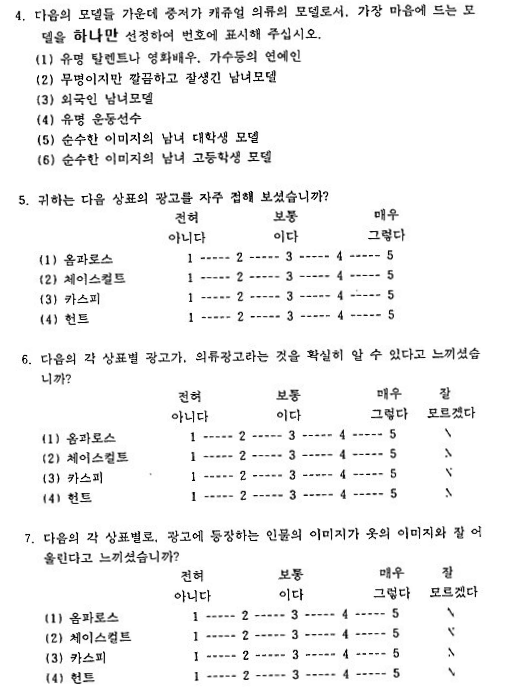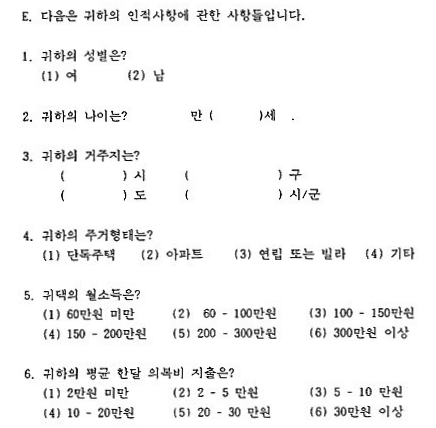국 내 문 헌
1) 이 우용, 정 구현, 마케팅원론, 형설출판사, 재판, 1994, p.136
2) 한 민희, 장 대련, 광고경영론, 학현사. 1994. pp,145-147
3) 광고정보, 한국방송광고공사, 1994.1. pp.61-64.
4) 임 종원, 현대마아케팅관리론, 1987, 무역경영사, PP.155-156
외 국 문 헌
1) Banks. S.. "Some Correlates of Coffee and Cleanser Brand Shares. Journal of Advertising Research, June 1961. pp.22-28.
2) Bass, F.M , D.J. Tigert and R.T. Lonsdale. "Market Segmentation : versus Individual Behavior. " Journal of Marketing Research , Aug. 1968. p.276
3) Bell. M., Marketing: Concepts and Strategy. 3rd ed., Boston, Mufflin Company. 1979. p.126.
4) Brandt , S. C..
Journal of Marketing. Vol.30 No.4. 1966. p 25.
5) Cayley. H.A., H F. Fiorillo and J.F. Engel "Segmentation:It's Place Marketing Management. " The Business Quarterly. Spring-Summer 1971. pp.64-75.
6) Dhalla. N. K. and W. H Mahatoo. "Expanding the Scope of Segmentation Research. " Journal of Marketing, Apri1 1976, pp.34-41
7) Dickson, P. R., "Person-Situation: Segmentation's Missing Link, " Journal of Marketing, Fal1 1982. pp.56-64.
8) Evance, F. B., "Psychological and Objective Factors in the Prediction of Brand Choice. " Journal of Business. Vol.32, Oct. 1959 pp.340-369.
9) Frank, R E.. "Is Brand Loyalty a Useful Basis for Market Segmentation?. " Journal of Advertising Research. June 1967, pp.27-33
10) Frank, R E.., "Correlates of Buying Behavior for Grocery Product. " Journal of Marketing. Oct. 1967. pp.48-53.
11) Frank, R E.., W.F. Massy and Y. Wind, Market Segmentation, Eaglewood Cliffs. New Jersey, Prentice-Hall, 1972. p 27.
12) Green. P.E., Y. Wind and A.K. Jain, "Benefit Bundle Analysis," Journal of Advertising Research. Vol.3 No.2. 1972. pp.31-36
13) Haley, R. J., "Benefit Segmentation : A Dicision Oriented Research Tool." Journal of Marketing. July 1968. pp.30-35.
14) Hawes. D.K. , R.D. Blackwell and W.W. Talarzyk. "Attitude toward Use of Credit Cards: Do Men and Women Differ?. " Baylor Bisiness Studies. Jan 1977. pp.61-67.
15) Kalmen, J.M., "Personality and Food Preference. " Journal of Advetising Research, Sep. 1964. pp27-32.
16) Koponen, A. "Personality Characteristics of Purchaser. " Journal of Advertising Research, Vol.1, Sep. 1960. pp.6-12.
17) Kotler. P., Marketing Management: Analysis, Planning and Control Prentice-Hall. 1972, p.168.
18) Kotler. P., Marketing Management: Analysis, Planning and Control, 4th ed. , Eaglewood Cliffs, N.J., Prentice-Hall. 1980, pp.199-205.
19) Massy. W. F. and R. E. Frank, 'Short term Price and Appealing Effects in Sel ected Market Segments. " Journal of Marketing Research, May 1965, pp. 178-179.
20) McCarthy. E J.. Basic Marketing, 7th ed., Homewood Illinoise, Richard 0. Irwin. Inc., 1981. p 223.
21) Plummer. J.T . "The Concept and Application of Life Style Segmentation, " Journal of Marketing. Vol. 38. Jan. 1974. p.33.
22) Smith, W.R., "Product Differentiation and Market Segmentation as Alternative Marketing Strategies," Journal of Marketing, July 1956.
23) Stewart, J. B . "Fundamental Features in Product Strategy. " Harvard Business Review. March-Apri1 1959. p.75.
24) Twedt, D.W. "How Important to Marketing Strategy in the 'Heavy User'?." Journal of Marketing. Jan. 1964, p.72.
25) Twedt, D.W., The Concept of Market Segmentation, in V.P.Buell and C. Heyel (eds) Handbook of Modern Marketing, 1970. pp.2-14.
26) Wells, W.D., "Psychographics : A Critical Review, " Journal of Marketing Research. May 1975. pp.196-213.
27) Westfall, R., "Psychological Factors in Predicting Product Choice. " Journal of Marketing, Apri1 1962, pp.34-40.
28) Wind, Y., "Issues and Advances in Segmentation Research, " Journal of Marketing Research. Aug 1978, p.317.
29) Yankelovich. D., "New Criteria for Market Segmentation, " Harvard Business Review, March-Apri1 1964. pp.83-84.
30) Yankelovich. D., "New Criteria for Market Segmentation." In E. J. Kelley and W. Lazer, ed., pp.195-196.
31) Young, S., L. Ott and B. Feigin. "Some Practical Considerations in Market Segmentation. " Journal of Markering Research. Aug. 1978. p.405.
32) Ziff, R., "Psychographics for Market Segmentation. " Journal of Advertising Research, Apri1 1971, p.3.
ABSTRACT
A Study on the Difference of Product Attitude and Advertising Attitude among Market Segments
Ahn Il-Yong(Department of Business Administration, The Graduate Schoo1 Yonsei University)
The objective of this research is finding out the differences among groups in product attitute and advertising attitude perspectives. In doing so, the mid and low-priced casual wear market has been segmented by its stock of casual wear and consumer's attitude towards clothing. In addition to that, the results provide a market segmentation guideline for product strategy and advertising strategy.
In order to conduct this research, theory on market segmetnation has been taken into account while a convenience sampling method has been used for a survey on college students.
The results of 172 valid data are as follows.
Each market segment by its stock of casual wear shows valid differences among product attitude, so this market segmentation method will be useful in product strategy decisions.
Results also suggest that each market segment by consumer's attitude toward clothing shows valid differences among advertising attitude, and therefore this segmentation method will be useful in advertising strategy decisions.
Key words: Market segmentation. Casual wear, Product attitude, Advertising




